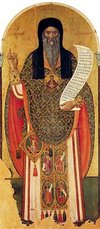Difference between revisions of "Template:Featured"
m |
(Lindisfarne => John of Damascus) |
||
| Line 4: | Line 4: | ||
</div> | </div> | ||
<!--nb. portrait images at ~100px, landscape images at ~200px--> | <!--nb. portrait images at ~100px, landscape images at ~200px--> | ||
| − | [[Image: | + | [[Image:John_of_Damascus.jpg|100px|left]]Our venerable and God-bearing Father '''John of Damascus''' (c. 676 - [[December 5]], 749) was also known as ''John Damascene, Chrysorrhoas,'' "streaming with gold," (i.e., the golden speaker). He was born and raised in Damascus, in all probability at the [[Monastery of Saint Sabbas]] (''Mar Saba''), South East of Jerusalem. He died in 749 as a revered Father of the Church, with his feast celebrated on [[December 4]]. |
| − | + | John's family had a high position in the Muslim rulers of Damascus, and on the death of his father was made chief councillor of Damascus. Around this time, the burst of insurgence by the [[iconoclasm|iconoclasts]] began to appear in the form of heresy, which disturbed the Church of the East. In 726, in disregard of the protests of Germanus, Patriarch of Constantinople, Emperor [[Leo the Isaurian]] issued his first edict against the veneration of images and their exhibition in public places. A talented writer and in the secure surroundings of the caliph's court, ''John de Damascene'' initiated his literary defense against the monarch in three ''Apologetic Treatises against those Decrying the Holy Images''. This was the earliest of his works and the one which earned him a reputation. | |
| − | + | Unable to punish the writer openly, Leo the Isaurian forged a letter from John to the Isaurian monarch offering to betray the city of Damascus. Despite John's plea of innocence, the caliph dismissed his plea and discharged him from his post, ordering his writing hand to be severed at the wrist. His hand was miraculously restored after fervent prayer before an icon of the Virgin Mary, and at this point the caliph was convinced of his innocence and wished to reinstate him to his former office. However, John then retired to the [[Monastery of Saint Sabbas]] near Jerusalem, where he continued to produce a stream of commentaries, hymns and apologetic writings, including the [[Oktoechos]] (the Church's service book of eight tones) and ''An Exact Exposition of the Orthodox Faith'', a summary of the dogmatic writings of the Early Church Fathers. | |
| − | + | '''''Recently featured:''''' [[Lindisfarne]], [[Edward the Martyr]], [[Victor Pokrovsky]], [[Akathist]], [[Apostles]], [[Irene Chrysovalantou]], [[Paschal greeting]]. ''Newly [[:Category:Featured Articles|featured articles]] are presented every '''Friday'''.'' | |
| − | '''''Recently featured:''''' [[Edward the Martyr]], [[Victor Pokrovsky]], [[Akathist]], [[Apostles]], [[Irene Chrysovalantou]], [[Paschal greeting]]. ''Newly [[:Category:Featured Articles|featured articles]] are presented every '''Friday'''.'' | ||
Revision as of 22:37, June 16, 2006
John's family had a high position in the Muslim rulers of Damascus, and on the death of his father was made chief councillor of Damascus. Around this time, the burst of insurgence by the iconoclasts began to appear in the form of heresy, which disturbed the Church of the East. In 726, in disregard of the protests of Germanus, Patriarch of Constantinople, Emperor Leo the Isaurian issued his first edict against the veneration of images and their exhibition in public places. A talented writer and in the secure surroundings of the caliph's court, John de Damascene initiated his literary defense against the monarch in three Apologetic Treatises against those Decrying the Holy Images. This was the earliest of his works and the one which earned him a reputation.
Unable to punish the writer openly, Leo the Isaurian forged a letter from John to the Isaurian monarch offering to betray the city of Damascus. Despite John's plea of innocence, the caliph dismissed his plea and discharged him from his post, ordering his writing hand to be severed at the wrist. His hand was miraculously restored after fervent prayer before an icon of the Virgin Mary, and at this point the caliph was convinced of his innocence and wished to reinstate him to his former office. However, John then retired to the Monastery of Saint Sabbas near Jerusalem, where he continued to produce a stream of commentaries, hymns and apologetic writings, including the Oktoechos (the Church's service book of eight tones) and An Exact Exposition of the Orthodox Faith, a summary of the dogmatic writings of the Early Church Fathers.
Recently featured: Lindisfarne, Edward the Martyr, Victor Pokrovsky, Akathist, Apostles, Irene Chrysovalantou, Paschal greeting. Newly featured articles are presented every Friday.
